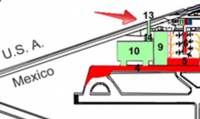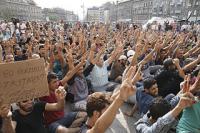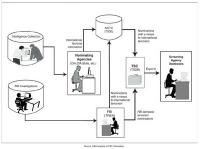-
Israel-Turkey rapprochement; refugees’ jewelry in Denmark; mysterious death in Argentina
Israel and Turkey were once close allies, but the relationship between the two countries has cooled after the Islamist party of President Recep Tayeep Erdogan came to power in 2002, and he was elected president in 2003. The two countries have decided that the many challenges they face in common now justify the resumption of normal relationship, even if the two countries are deeply divided over the treatment of the Palestinians by Israel; Denmark is set to pass a law which would allow authorities to confiscate jewelry from refugees entering Denmark in order to pay for some of the refugee-related expenditures by the government; the new government in Argentina will reopen the investigation in to the mysterious death in January of a prosecutor who was about to charge former president Cristina Fernandez de Kirchner with covering up Iran’s involvement in the killing of eighty-five Argentinian Jews in 1994.
-
-
Syrian Refugees in Jordan and Lebanon: Young, female, at risk
Nearly nine in ten registered Syrian refugees living in Jordan are either poor or expected to be in the near future, a new World Bank report says. The nearly 1.7 million Syrians who are registered in neighboring Jordan and Lebanon live in precarious circumstances. The World Bank estimates that there are currently sixty million people forcibly displaced globally — as refugees, internally displaced persons, and asylum seekers fleeing conflict and persecution. Most of the displaced people are concentrated in developing countries.
-
-
The economic impact of refugees in Sweden
The world currently has more refugees and internally displaced persons than it has had since the Second World War. Many countries are reluctant to take refugees in. Security is a recent concern, but a major underlying reason is the perceived financial burden which would result from larger intake of refugees. But what, in reality, is the economic impact of these new arrivals? Since 2005, Sweden has taken in more refugees per capita than any other European country. A detailed study of the Swedish case shows that the acceptance of those refugees has resulted in a net fiscal redistribution from the non-refugee population to refugees corresponding to 1.0 percent of Swedish GDP – with four-fifths of the redistribution due to lower public per capita revenues from refugees. A clear takeaway from this research is that policies should focus on integrating refugees into the labor market as quickly as possible.
-
-
U.S. officials barred from reviewing social media postings of visa applicants
Officials from DHS and the Department of State, as a general policy, do not check social media postings of applicants out of civil liberties concerns. With this policy in place, the department’s officials who handled Tashfeen Malik’s application could not have seen her pro-ISIS postings and note her growing radicalization. Officials from United States Citizenship and Immigration Services (USCIS) and U.S. Immigration and Customs Enforcement (ICE) pressed for a change in DHS policy in light of the fact that social media is increasingly used by followers of jihadist groups to declare their allegiance, but the disclosures by Edward Snowden about NSA surveillance programs was behind the reluctance of DHS high officials to change the policy for fears such a change would further damage the administration’s standing with civil rights groups and European allies.
-
-
The third intifada; new, smaller Schengen; EU border patrol
Mahmud Abbas, the president of the Palestinian Authority, has been warned by the military wing of the PLO that unless he can persuade the UN Security Council to vote for a resolution calling for the creation of an independent Palestinian state, a new intifada will be launched to convince Israel that a continued occupation of Palestinian lands will be costly; European officials are planning to abandon the 30-year old Schengen Agreement and replace it with a much smaller, Western Europe-only free-travel zone; facing rising seas, residents of the Pacific island of Tuvalu are looking for a new home.
-
-
Merkel: Germany will “drastically reduce” number of refugees arriving in Germany

German chancellor Angela Merkel said Sunday that she wanted to “drastically decrease” the number of refugees coming to Germany, indicating she would willing to compromise with critics within her own conservative party, the Christian Democratic Union (CDU). These critics have charged that her open-door policy posed security risks to Germany and would expand the government welfare rolls.
-
-
CBP begins biometric entry/exit testing at Otay Mesa port of entry

U.S. Customs and Border Protection (CBP) will begin testing new biometric technology at the Otay Mesa pedestrian crossing this week to enhance identification of certain non-U.S. citizens entering and exiting the United States. CBP says its Entry/Exit strategy includes three core pillars: identify and close the biographic gaps and enhance the entry-exit system; perform targeted biometric operations; and transform the entry/exit process through the use of emerging biometric technologies.
-
-
Tijuana airport’s bridge-connected terminals straddle U.S.-Mexico border

The Tijuana airport is only the second airport in the world straddling an international border, with terminals on each side of the U.S.-Mexico border. Before the bridge opened, travelers had to drive a rental car or be driven in shuttle buses for about fifteen minutes to a crowded land crossing, where they often had to wait several hours to enter San Diego by car or on foot. On the new airport bridge, it takes passengers five minutes to walk to a U.S. border inspector.
-
-
Refugee system “vulnerable to exploitation from extremist groups”: U.S. intelligence

On Monday, in his inaugural State of Homeland Security Address, House Homeland Security Committee chairman Michael McCaul (R-Texas) highlighted new concerns regarding refugees with ties to terrorist groups in Syria who might try to enter the United States. He revealed that a letter sent to him earlier this year by the Office of the Director of National Intelligence stated that “The refugee system, like all immigration programs, is vulnerable to exploitation from extremist groups seeking to send operatives to the West.”
-
-
Trump calls for barring all Muslims from entering U.S. (updated)

In an extraordinary rhetorical escalation Donald Trump on Monday called for a “total and complete” ban on Muslims entering the United States because, he argued, Islam is rooted in hatred and violence. The ban should be in place until the country’s leaders and security agencies can “figure out what is going on.” Trump’s campaign manager Corey Lewandowski told the Associated Press that the ban would apply to “everybody,” including both immigrants and tourists.
-
-
French regional elections: No one can dismiss Le Pen as an also-ran now

Marine Le Pen probably won’t be the next president of France, but the regional elections are proving that her Front National has truly become a major player. Le Pen’s party has taken 28 percent of the vote in the first of two rounds to elect regional assemblies. The right-wing Republicans, led by former president Nicolas Sarkozy, came a close second, with a shade under 27 percent. The ruling Socialist Party trailed, with just 23 percent of the vote. There is one week to go until the decisive second round, but even if the left and right somehow manage to block their path, the FN has already struck a major blow ahead of the presidential election in 2017.
-
-
Trump Calls for preventing all Muslims, including immigrants and tourists, from entering U.S.
In what must be seen as an extraordinary rhetorical escalation even for a presidential candidate not known for nuance and subtlety, Donald J. Trump on Monday called for the United States to prevent all Muslims, without exception, from entering the United States until the country’s leaders and security agencies can “figure out what is going on.” Trump’s campaign manager Corey Lewandowski told the Associated Press that the ban would apply to “everybody,” including both immigrants and tourists.
-
-
72 DHS employees were found to be on the terrorist watch-list

Representative Stephen Lynch (D-Massachusetts) was among the forty-seven Democrats who supported a GOP bill to tighten screening requirements for Syrian and Iraqi refugees. He explains: “I have very low confidence [in DHS’s ability to vet refugees] based on empirical data that we’ve got on the Department of Homeland Security. I think we desperately need another set of eyeballs looking at the vetting process.” He also revealed that a DHS IG investigation found that seventy-two DHS employees were on the terrorist watch list.
-
-
GOP lawmakers draft bill to bolster Visa Waiver security

About twenty million people use the Visa Waiver program to come to the United States every year. A bill being considered in the House would block anyone who has traveled to Syria, Iraq or a few other nations in the past five years from participating in the Visa Waiver program. It would also require the United States to collect more information about those who avail themselves of the program, codifying a policy already in place.
-
-
Texas sues to block resettlement of Syrian refugees

The Texas Health and Human Services Commission on Wednesday filed suits in federal court against the U.S. State Department, the International Rescue Committee (IRC), and other organizations as part of the state effort to block the resettlement of Syrian refugees in Texas.
-
- All
- Regional
- Water
- Biometrics
- Borders/Immig
- Business
- Cybersecurity
- Detection
- Disasters
- Government
- Infrastructure
- International
- Public health
- Public Safety
- Communication interoperabillity
- Emergency services
- Emergency medical services
- Fire
- First response
- IEDs
- Law Enforcement
- Law Enforcement Technology
- Military technology
- Nonlethal weapons
- Nuclear weapons
- Personal protection equipment
- Police
- Notification /alert systems
- Situational awareness
- Weapons systems
- Sci-Tech
- Sector Reports
- Surveillance
- Transportation
Advertising & Marketing: advertise@newswirepubs.com
Editorial: editor@newswirepubs.com
General: info@newswirepubs.com
2010-2011 © News Wire Publications, LLC News Wire Publications, LLC
220 Old Country Road | Suite 200 | Mineola | New York | 11501
Permissions and Policies
Editorial: editor@newswirepubs.com
General: info@newswirepubs.com
2010-2011 © News Wire Publications, LLC News Wire Publications, LLC
220 Old Country Road | Suite 200 | Mineola | New York | 11501
Permissions and Policies
